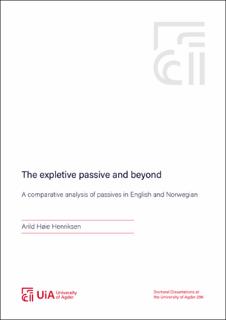| dc.contributor.author | Henriksen, Arild Høie | |
| dc.date.accessioned | 2020-10-20T09:20:03Z | |
| dc.date.available | 2020-10-20T09:20:03Z | |
| dc.date.created | 2020-10-14T12:46:27Z | |
| dc.date.issued | 2020 | |
| dc.identifier.citation | Henriksen, A. H. (2020). The expletive passive and beyond : A comparative analysis of passives in English and Norwegian (Doctoral thesis). University of Agder, Kristiansand. | en_US |
| dc.identifier.isbn | 978-82-7117-998-4 | |
| dc.identifier.issn | 1504-9272 | |
| dc.identifier.uri | https://hdl.handle.net/11250/2683829 | |
| dc.description.abstract | This thesis argues that passives in English and Norwegian can be explained by a casetheoretic approach inspired by Chomsky (1981, 1995, 2000 and 2001). I argue that the passive morpheme originates in little v and blocks little v's case-assigning properties in English but not in Norwegian. Thus the passive feature —[PASS]—forces a postverbal DP to move out of the vP phase in English so that the basic passive, although seemingly driven by the EPP, is in reality a result of a combination of the EPP and case theory. Following Bruening (2013), I further argue that the by-phrase is an adjunct just like instrumental PPs that can be freely inserted in structures that have external arguments that are free, such as passives and certain nominals. As such, by-phrases are blocked from occurring with middles or unaccusatives, and this is the same thing that happens with instrumentals and comitatives. | en_US |
| dc.language.iso | eng | en_US |
| dc.publisher | 07 Media | en_US |
| dc.relation.ispartofseries | Doctoral Dissertations at the University of Agder; no. 296 | |
| dc.title | The expletive passive and beyond : A comparative analysis of passives in English and Norwegian | en_US |
| dc.type | Doctoral thesis | en_US |
| dc.description.version | publishedVersion | en_US |
| dc.rights.holder | © 2020 Arild Høie Henriksen | en_US |
| dc.subject.nsi | VDP::English language: 020 | en_US |
| dc.source.pagenumber | 232 | en_US |
| dc.source.issue | 296 | en_US |
| dc.identifier.cristin | 1839531 | |
